
The Rudraksha tree, scientifically known as Elaeocarpus ganitrus, is a large, evergreen tree primarily found in tropical and subtropical regions, especially in the foothills of the Himalayas, and regions like Nepal, Indonesia, and parts of India. It is highly valued in Hinduism, Buddhism, and other spiritual traditions for the unique and sacred seeds it produces, known as Rudraksha beads. Rudraksha is a compound term in Sanskrit, which means Shiva’s teardrop (split into two words) Rudra (Shiva’s Vedic name) and Aksha –teardrop. Other sources state that ‘Aksha’ is also an eye, which means Rudraksha represents Bhagwan Shiva’s eye.
Read More: Everything about Rudraksha
Quick Facts about Rudraksha Tree
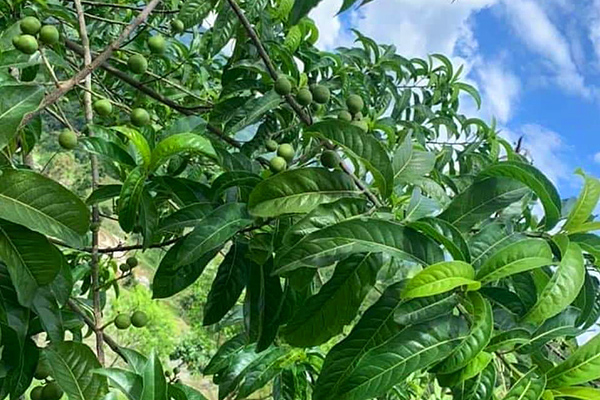
There are more than 300 species of Rudraksha found across the world.
India has around 35 different species.
Rudraksha trees in India are grown 3000m above the sea level.
It grows in a narrow space
The leaf of tree resembles tamarind leaves
The scientific name of Rudraksha tree is Elaeocarpus Ganitrus Roxb, which grows 60 to 80 feet tall. This is the most common species of the Rudraksha tree. Dr. William Roxburgh, a Scottish surgeon and botanist, gave this species its botanical name. The scientific name has its Greek origin. ‘Elae’ means ‘wild olive’ and ‘Carpus’ means ’fruit’.
What is Rudraksha Tree
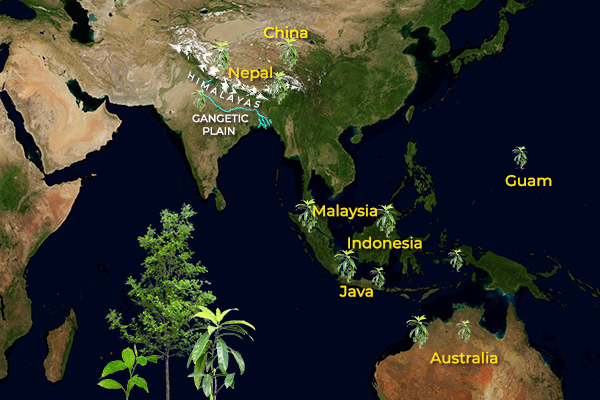
Many epics and ancient scriptures in Hinduism detailed the specifications of this specific species. This popular species grows in Nepal and Indonesia. These two countries regulated organized cultivation for Rudraksha.
Besides, the trees are predominantly seen in the foothills of the Himalayas, from the Gangetic Plain and spread across Southeast Asia. Countries that grow Rudraksha trees include Indonesia, China, Java, Malaysia, Australia and Guam. The tree grows from 10 to 30 meters tall. The body trunk measures 1 meter width. Unlike other trees, Rudraksha trees are grey in color. It takes three or four years to bear fruit after germination. Besides, when the tree matures, the roots of the tree form a defense. It rises and radiates across the ground surface.
Rudraksha Tree Benefits
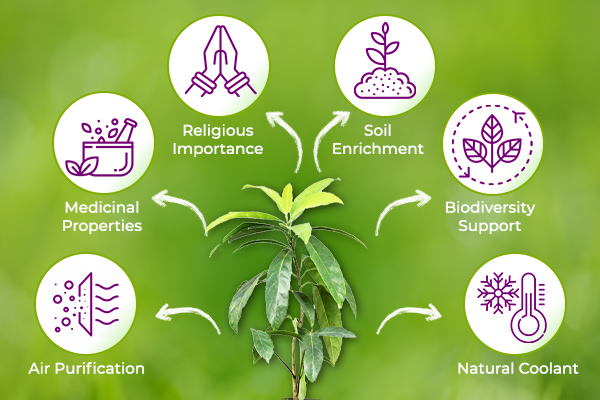
Rudraksha tree has multiple benefits, from its leaves to its fruits, everything has its own significance.
Air Purification:
These trees contribute to the process of air purification, so making an important impact in the promotion of a healthy atmosphere.
Medicinal Properties:
The leaves, bark, and seeds of this plant are used in traditional medicine to treat conditions such as headaches, skin diseases, and stress.
Religious Importance:
The beads of the tree have religious significance, fostering spiritual health and protection.
Soil Enrichment:
The tree improves soil fertility and reduces erosion, hence promoting sustainable agriculture.
Biodiversity Support:
Facilitates the existence of diverse species by providing a suitable environment, hence sustaining local ecosystems.
Natural Coolant:
The shade generated by the Rudraksha tree acts as a natural coolant, making it an ideal option for planting near residential areas.
History, Significance & Importance of Rudraksha Tree:
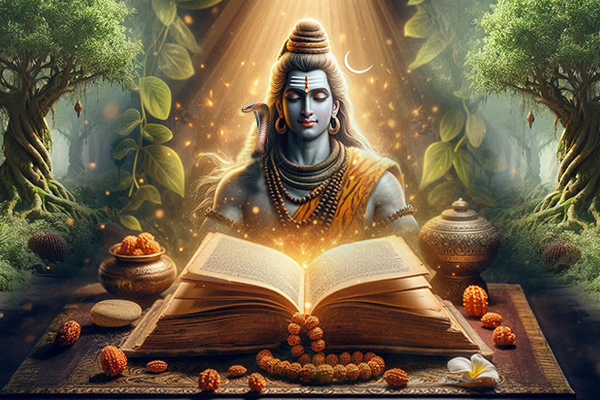
The Rudraksha tree, scientifically known as Elaeocarpus Ganitrus, has a profound historical significance in Hindu mythology and spiritual customs. Based on ancient traditions, the tree's origin may be traced back to the tears shed by Lord Shiva. These tears fell to the ground and gave rise to these renowned trees. The Rudraksha tree's beads have been highly esteemed for its spiritual and therapeutic attributes in India, Nepal, and other regions of Southeast Asia for generations. The significance of these beads in spiritual activities and rites is emphasized in ancient writings such as the Shiva Purana, Devi Bhagavatam, and the Upanishads.
The Rudraksha tree is very significant both in terms of spirituality and medicine. From a spiritual perspective, the beads derived from this tree are seen as physical manifestations of divine energy and are said to provide the wearer with protection, peacefulness, and development in their spiritual journey. They are often used in the practice of meditation and prayer, assisting in the harmony of the mind, body, and soul. Medicinally, many components of the tree, such as the leaves, bark, and seeds, have been used in traditional medicine to treat conditions including high blood pressure, skin disorders, and psychological strain. Therefore, the tree is regarded as holy and often cultivated close to temples and spiritual hubs.
The significance of the Rudraksha tree is beyond its spiritual and medicinal uses. Environmentally, it has a vital function in preserving the balance of nature by improving soil fertility and promoting biodiversity. The tree offers shade and functions as a natural cooling system, making it advantageous for plantations close to residences and communities. The Rudraksha tree beads have significant economic significance and are integral components of traditional and spiritual jewelry, playing a crucial role in supporting the lives of several populations living in locations where these trees are found. The Rudraksha tree symbolizes spiritual legacy, holistic healing, and ecological sustainability.
Read More:
Story of Rudraksha
Rudraksha Trees in Himalayan Region
The Rudraksha trees that grow in the Himalayan region hold the highest power, strength and healing properties. Himalayas (Kailash), a holy mountain, are considered the abode of Lord Shiva, surrounded by the rivers and anything that grows in this region holds supreme power. The Rudraksha bead has a hard surface and deep projections. The beads from Nepal and Indian trees show grooved and deep projections on the surface which indicates deep valleys and hills.
Leaves, Flowers & Fruits of Rudraksha Tree
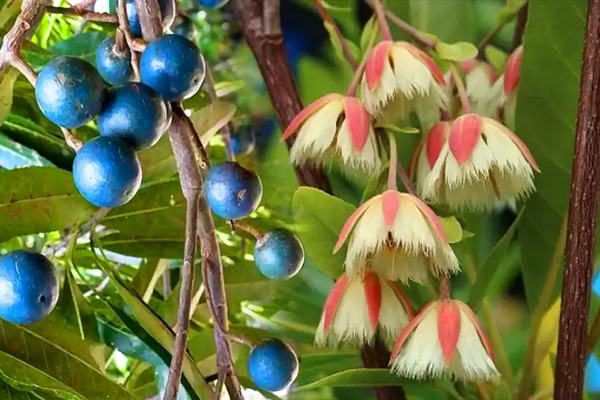
Apart from the spiritual healing, all parts of the Rudraksha trees have medicinal properties. The tree appears like a mango tree and is usually large. The tree sheds its leaves and re-grows the fresh ones naturally. The leaves of the tree contain anti-bacterial properties. In ancient days, the leaves were used to treat wounds. The white flowers of Rudraksha trees grow in big bunches. It looks beautiful and majestic to witness the blossoms during the months of November and December. The tree bears fruit during the months of January and February.
The fruits appear like berries in green color. Ripened fruits gradually turn blue. A blue colored husk covers the Rudraksha seeds, which yielded the name blueberry beads. As stated earlier, the size of the fruit and seeds depends on the region where the tree grows. Fully ripened fruits fall naturally. The seed i.e. the bead is found after removing the outer skin and fleshy part.
In Ayurveda, the ancient medical system uses all parts of the Rudraksha tree for healing and balancing the body and mind.
Rudraksha tree leaves treat many conditions like headache, migraine, epilepsy and mental disorders.
The outer layer of the fruit was used to treat cold flu and fever.
The leaves / fruit skin is used to purify blood.
According to Ayurvedic texts, Rudraksha strengthens your body, enhances your immunity, evokes natural healing power, and promotes overall health.
Different Types of Rudraksha Beads from the Tree
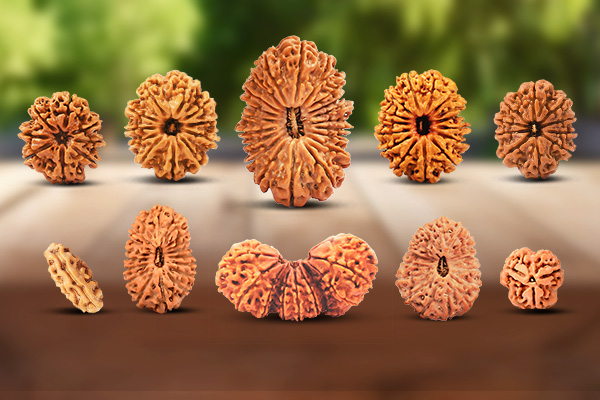
Rudraksha Tree produces a type of fruit which is known as Rudraksha berry, this fruit is distinguished by unique grooves or mukhis or faces etched on the external surface. The number of Mukhis on the surface more or less correspond to the number of compartments & seeds or subdivisions inside the berry. These are recognized as different Mukhis or Variety of Rudraksha possessing different benefits. These typically range from 1 to 21 Mukhi however in recent years upto 30 Mukhi has been found in Nepal Variety & 42 Mukhi in Java Variety has been found in Nature
Sometimes the Rudraksha Fruits also undergo a natural process of cojoining or twinning wherein 2 or more beads are co-joined naturally. These varieties includes
Gaurishankar:
When 2 Rudraksha Fruit of equal sizes cojoin naturally symbolizing Shiva & Parvati (Gauri-Shankar)
Trijuti:
When 3 Rudraksha Fruits cojoin naturally symbolizing Brahma, Vishnu & Shiva
Garb Gauri:
When 2 Rudraksha Fruit, one bigger than the other, cojoin naturally symbolizing Ganesh inside Parvati’s Womb
Savar Naag:
When 2 Rudraksha Fruits cojoin naturally where 1 Fruit has only 1 Mukhi or face symbolizing Shiva with a Hooded Serpent behind him
Ganesh:
Here Rudraksha Fruit doesn’t have a completely developed bead attached but instead a protrusion which symbolizes the trunk of Bhagwan Ganesh
Read More:
Different Types of Rudraksha
Can You Grow Rudraksha Tree at Home?
Anyone can plant and nurture the Rudraksha trees at home. It doesn’t need any specific climatic conditions to grow. However, you must ensure to prepare the soil before planting or seeding. You can grow Rudraksha tree by planting a sapling or soiling a special bead. It takes about a year to sprout.
Rudraksha saplings also make an ideal gift to the temples, to near and dear ones. Gifting such items means bestowing them with spiritual gains.
How to Grow Rudraksha Tree at Home? (Planting Tips)
.jpg)
Following are the tips and guidelines for cultivating Rudraksha tree at home
Height and Growth:
Rudraksha trees have a maximum height range of 14.6 to 29.2 meters and possess wide leaves. Flowering starts during the summer season, while fruit maturation occurs in the middle of winter, often after 7 to 8 years.
Planting Location:
Select an area with temperatures that are lower than 35°C. Utilize a spacious container to prevent the roots from becoming entangled and place a pebble over the drainage hole to maintain moisture.
Soil Preparation:
To get the desired level of acidity, combine soil and peat moss in equal proportions. Pour the mixture into the pot, ensuring that there is a 3-inch gap between the mixture and the rim. Then, plant the seed at a depth of 1 inch.
Watering:
Water the plants at an interval of three days; it takes weeks to months for the seeds to germinate. When selecting a location for planting in gardens, choose a covered space of 30x30 feet to prevent exposure to direct sunlight.
Maintenance:
During the winter season, water plants are recommended daily. However, in the summer months, it is advisable to water them twice a day. The process of germination might last anywhere from 6 months to a year. Every spring, trim to preserve the size and replace topsoil with compost.
Fertilization:
Apply a fertilizer with a high concentration of potassium throughout the blooming and fruiting stages. Once trees reach a height of 2 feet, they develop endurance and can withstand occasional missed watering.
Tree Growth:
Full-grown trees attain heights of 30 to 60 feet, and their roots become visible if the soil is of low quality or densely packed. The lower branches descend after the leaves turn red.
If you are planning to plant Rudraksha plant, you can buy Rudraksha Seeds from the most trusted organization for Rudraksha, Rudra Centre.
Buy Rudraksha Seeds
Or if you do not want to go through the entire painstaking process of planting seeds, you can buy Nepal Rudraksha Plant directly from Rudra Centre.
Buy Nepal Rudraksha Plant
Rudraksha Tree Climate
Rudraksha tree primarily grows in the subtropical regions of the Himalayan foothills, including Nepal, India, and Bhutan. It is also found in parts of Southeast Asia, such as Indonesia and Malaysia, where the climate and soil conditions are favorable for its growth.
Rudraksha Tree Seeds
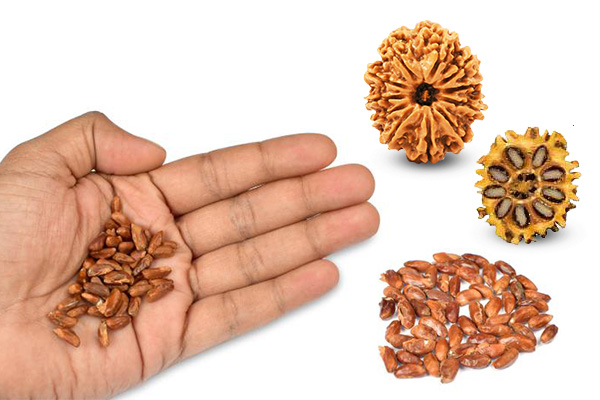
Rudraksha beads, derived from the seeds of the Rudraksha tree, have great significance in spiritual rituals, namely within Hinduism and Buddhism. These beads are regarded as holy and are believed to possess the heavenly force of Lord Shiva. Crystals are used in meditation, prayer, and chakra alignment to enhance spiritual growth, mental clarity, and protect against negative energies by harnessing their innate frequencies. Every Rudraksha bead is distinguished by the amount of Mukhi (natural segments or faces) it has, and each form provides distinct spiritual advantages.
Types of Rudraksha Tree
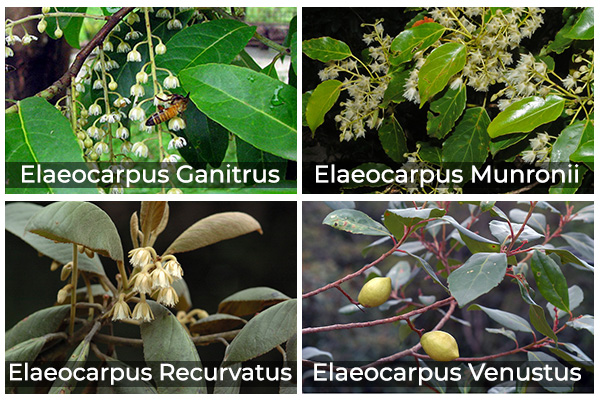
Elaeocarpus Ganitrus, commonly referred to as Rudraksha, is a specific species belonging to the Elaeocarpaceae family, which has over 605 species distributed among 13 genera. The Elaeocarpus genus has over 430 species, with a significant number distributed in tropical and subtropical climates worldwide.
In addition to Rudraksha, the Elaeocarpus genus has many additional species, a few of which are exclusive to certain regions:
Elaeocarpus Munronii is a plant that is native to the Western Ghats of India. It is recognized for its decorative and therapeutic properties.
Elaeocarpus Recurvatus is a species that may be found in the Western Ghats. It is known for its distinctive bent leaves and its ecological importance.
Elaeocarpus Venustus: This species, which is also found in the Western Ghats, is renowned for its aesthetic appeal and significance in conservation efforts.
The Elaeocarpus Ganitrus, along with each variant of Rudraksha bead and Elaeocarpus species, has distinct spiritual and ecological importance, making it a really extraordinary and multifaceted plant.

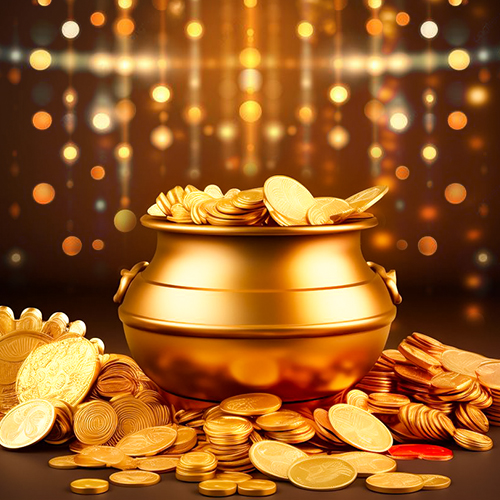
-in-Astrology.jpg)

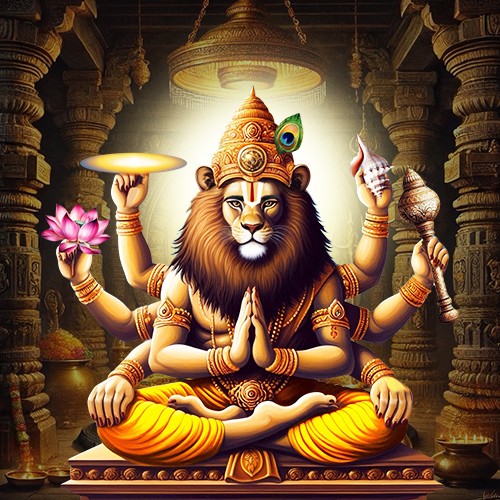
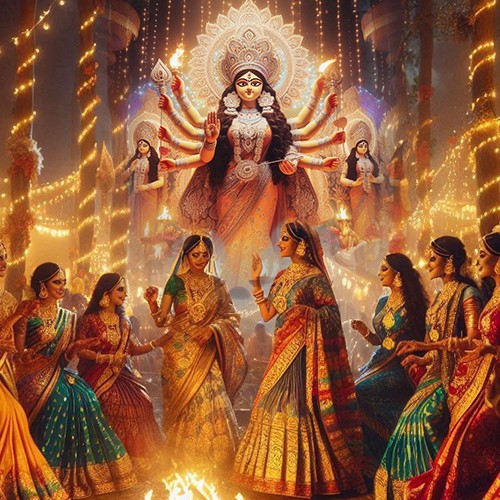
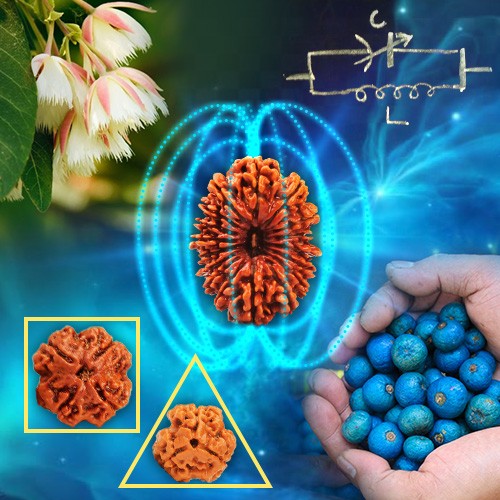

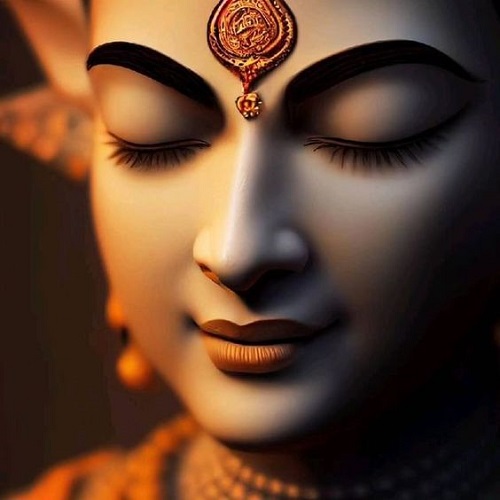
.jpg)
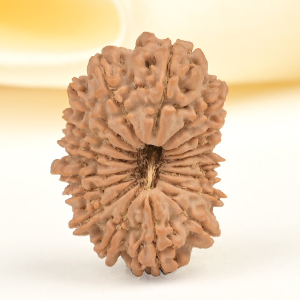
-Rudraksha-Beads---Thumbnail.jpg)
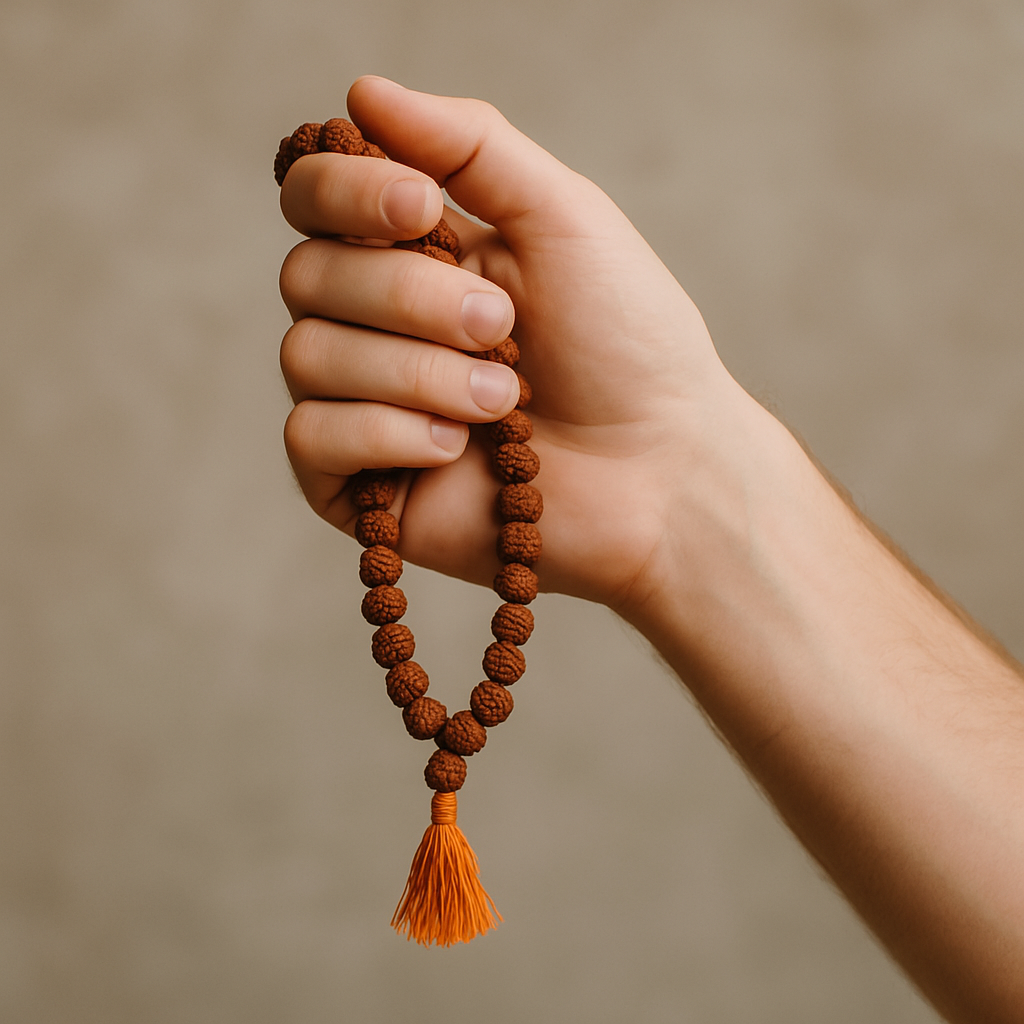

Comments 0
Leave your thought here